Scantily dressed women. A close-up of red lips. A seemingly nude couple locked in an embrace. Provocative images like these have been featured in advertisements for decades. Many advertisers, relying on the old adage “sex sells,” hope sensual ads will entice consumers to purchase their products. These print and video ads range from mildly suggestive to downright pornographic.
But what proportion of advertisements truly are sexually suggestive? And does sex really sell – or simply stir up controversy? We wanted to find out. First, we analysed video and print ads to see how heavily sexual themes feature among various industries, from fashion to food. Then we surveyed over 2,000 people to discern their opinions and feelings about suggestive content in advertisements. Does sex in advertising influence people’s purchase – or offend them? Read on to see what we discovered.
Ad Themes by industry
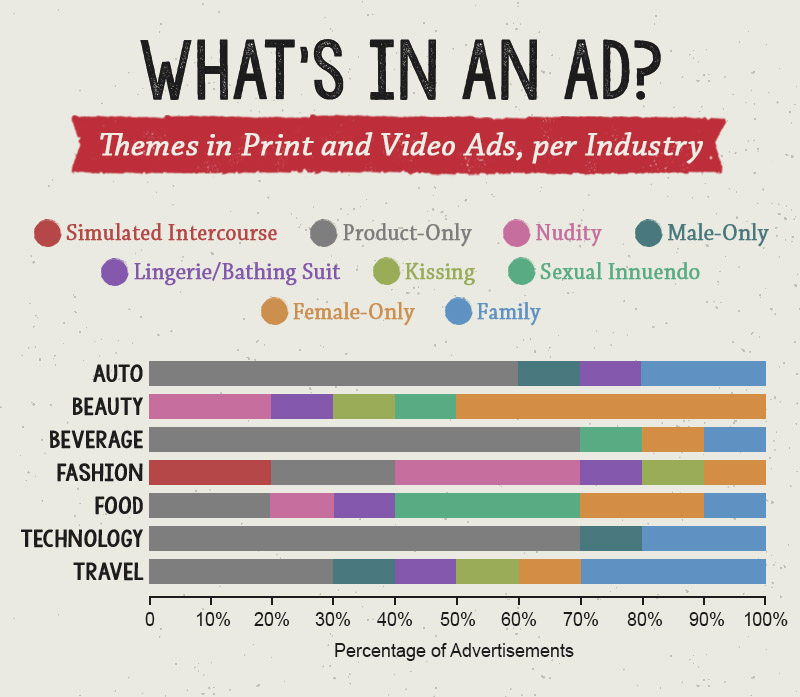
In order to analyse print and video advertisements, we separated themes by general content, such as family, kissing, and product-only. Of sexually related themes, we designated three specific types: innuendo (suggestive language and/or photos – for instance, a close-up of a woman’s mouth); nudity (which does not necessarily imply sex); and sex (which refers to simulated intercourse). Female-only and male-only categories refer to images featuring a clothed woman or man as the sole focus of the ad.
The fashion ads contained more sexual content than the rest: 70% of the fashion ads we examined contained sexual content. Breaking it down, 30% featured nudity, and 20% depicted simulated sex. Additionally, 10% featured kissing and another 10% showed a scantily dressed woman.
Half of all beauty ads featured women (clothed), and the other half featured varying levels of suggestion: 20% nudity, 10% sexual innuendo, 10% kissing, and 10% women in lingerie or bathing suit. Among the food industry ads, a surprising 30% conveyed innuendos, and 10% featured nudity.
None of the technology advertisements we examined featured sexual themes. Auto industry ads focused heavily on products, although 10% depicted women in lingerie/bathing suits. Travel industry ads ranked low in suggestive material as well: Just 10% depicted kissing and another 10% featured women in lingerie/bathing suits.
Ranking advertisement themes
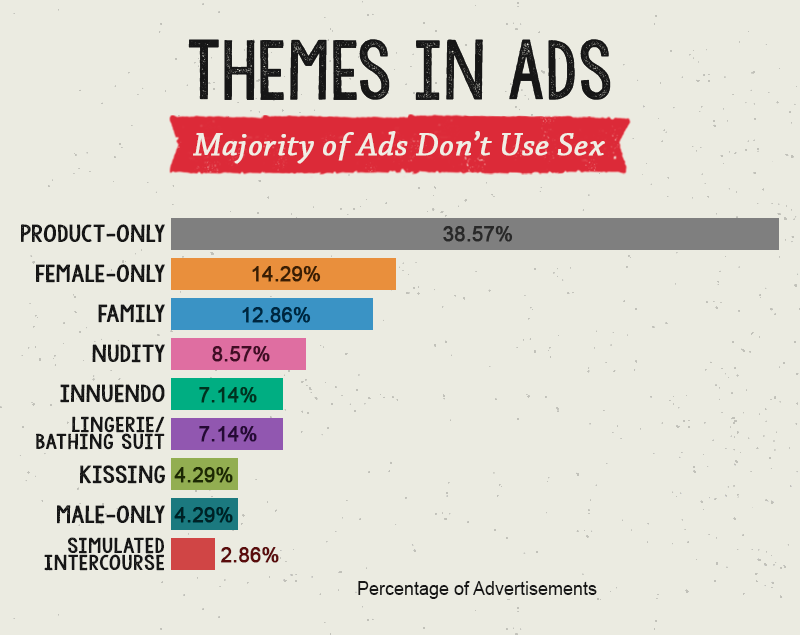
Though it may feel like sexual content features heavily in advertising, breaking down advertisements by theme reveals that the majority don’t employ sexual themes at all. In fact, a whopping 39% of ads depict only a product. Second-most common are ads featuring a clothed woman, followed by ads depicting families.
Nudity is the most common among risqué themes, appearing in nearly 9% of ads. Sexual innuendo (suggestive language or imagery) features in over 7% of ads. Fewer than 3% of advertisements depict simulated sexual intercourse. Interestingly, the second-least common theme after sex is male-only (featuring a clothed male) – these comprise just over 4%.
Which industries sexualise ads?
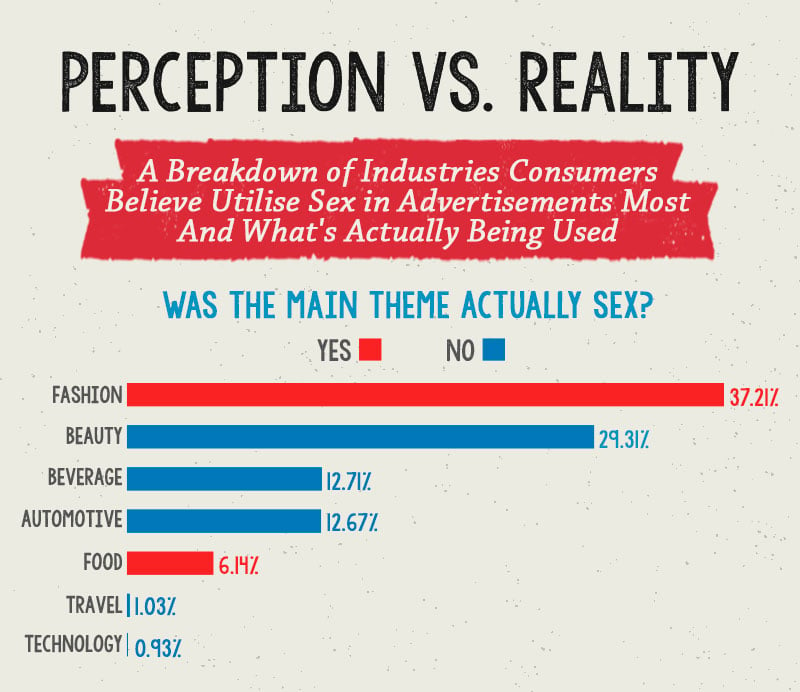
We surveyed people to find out which industries they believe rely most heavily on sexual themes in advertisements. Just over 37% of people believe that the fashion industry utilises sexual content more so than other industries – an accurate assessment based on our breakdown above. The beauty industry takes the No. 2 spot: 29% of people correctly noted its heavy use of sexual themes in ads.
Interestingly, nearly 13% of people we surveyed believed the beverage industry utilises suggestive ads most out of the categories above. However, in reality, our analysis revealed that only 10% of beverage ads feature sexual innuendos – and the majority depict the product only. And although 40% of food ads feature sexual themes, only 6% of people perceived the food industry as the category most likely to utilise sexual content in ads.
Sexual Vs. modest: which ads sell?
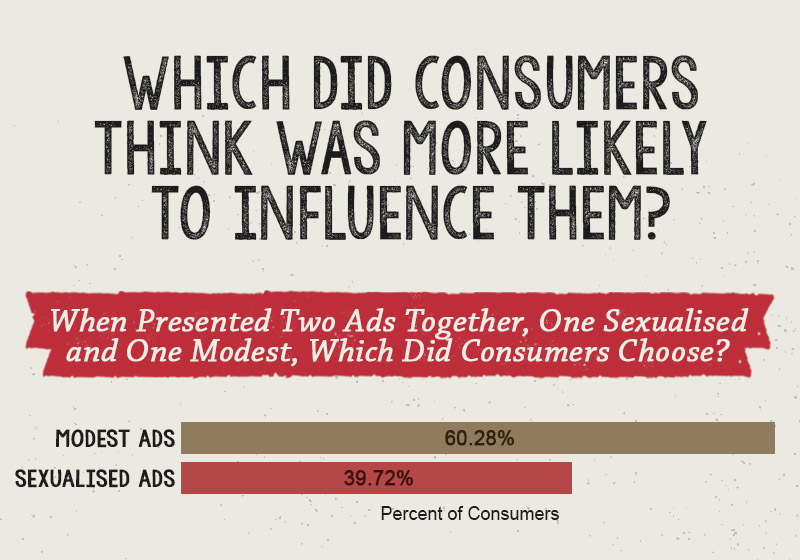
We presented two advertisements side by side and asked survey respondents to select which would make them more likely to purchase a product. Over 60% of people said the modest ads would make them more likely to buy that product, while nearly 40% thought the sexual ads were more apt to influence them. These results correlate with a recent study revealing that sexual content in advertisements does not translate into increased sales. And in fact, it showed that as sexual ad content intensified, people’s buying intentions actually decreased.
The influence of sexual ads

Next, let’s dig deeper into the results of our survey. The people who looked at sexual and modest ads side by side ranked the likelihood of each ad prompting them to purchase a product. Across the board, people ranked the modest ads as apter to influence buying decisions.
Fewer than 6% of people felt that the sexual ads would make them extremely likely to buy, while nearly 10% of people said the same about the modest ads. And nearly half of all respondents said they solely attribute those sales to that campaign...! The sexualised ads were perceived to make a purchase “not at all likely,” while fewer than 30% said the same about modest ads.
Te influence of attractive models
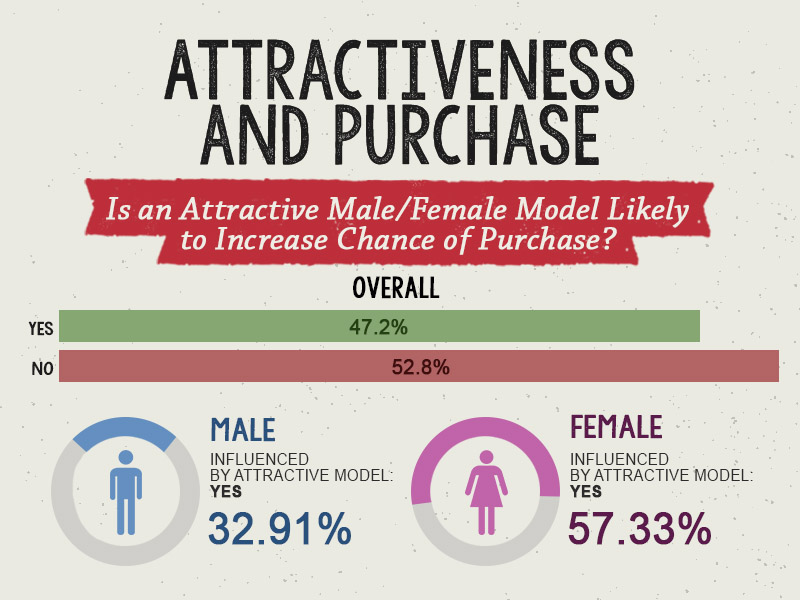
Although over 60% of people preferred modest ads to sexual ones, tackling the topic of attractive people featured in advertisements paints a slightly different picture. We asked whether the presence of an attractive man or woman increases the odds of purchasing a product. Surprisingly, overall, before breaking it down by gender, 47% of people said yes, while nearly 53% said no.
Who is offended by sexual ads?
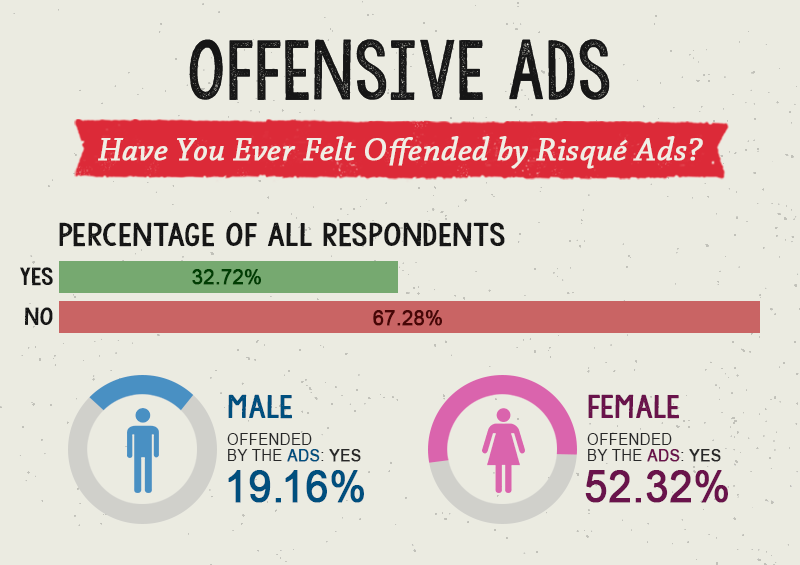
There’s no doubt that sexual ads can be controversial. However, among our survey respondents, only around 33% of people reported feeling offended by risqué ads. However, breaking down the results by gender tells a different story: Over 52% of women say they’re offended by sexual ads, while only around 19% of men say they are.
Survey respondents sounded off on the subject. “I believe that the sexualisation of a person to sell a product dehumanises the person in the advertisement and contributes to an inability to create meaningful relationships,” one participant wrote.
“I saw an attractive female in a suggestive pose which had nothing to do with the product being sold or its capabilities,” a male participant wrote. “I felt like the ad was insulting to me as a male because it assumed I could be swayed by such an image.”
Words like “objectification,” “demeaning,” and exploitation” cropped up frequently in comments: “I become irritated any time females are objectified for advertising purposes. It’s demeaning, and it oversexualises women,” one respondent wrote. Said another: “I think the exploitation of a woman’s body creates unrealistic expectations and normalises harmful attitudes.”
Sexuality and your health
The majority of ads we looked at don’t contain sexual content. However, sexually suggestive advertising is common among certain industries – especially fashion, beauty, and food. While consumers are certainly taking notice, the risqué content may not be prompting purchases the way advertisers might hope. In fact, 6 in 10 people preferred modest ads to sexualised ads, and over 3 in 10 people report they are actually offended by explicit ads.
As advertisers know, humans are sexual beings – and part of any positive sexual life means taking care of your health. At Superdrug Online Doctor, we empower you to be in the driver’s seat when it comes to your own reproductive health. After a discreet consultation with one of our certified medical professionals, you can have the products you need delivered discreetly to your door: STI test kits and treatments, contraceptives, and more.
Methodology
We analysed 70 ads from the different industries presented in the project and categorised a recent print ad and recent video ad for each category. We then presented modest and sexy ads to 2,000 users, both as side-by-side and separate images, to see which people tended to pick.
Sources
Fair Use
Feel free to share the images found on this page freely. When doing so, please attribute the authors by providing a link back to this page, so your readers can learn more about this project and the related research.
Donec non molestie ex. Etiam faucibus iaculis pharetra.
